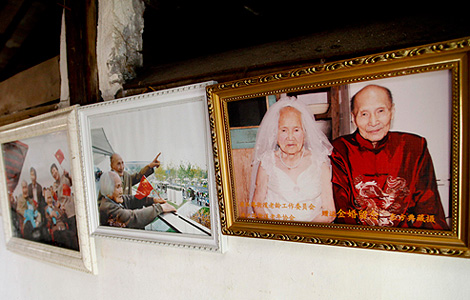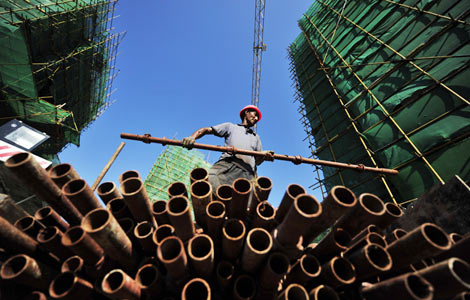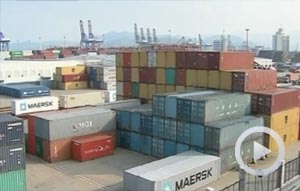Testing fresh ground for clean tech development
Updated: 2013-07-08 00:51
By Cecily Liu (China Daily)
|
||||||||
EU firms eye huge opportunities in the expanding Chinese market
China's rapid urbanization has provided an ideal market for the world's pioneering technologies on urban solutions to develop and commercialize in the country before being launched globally.
Research and development work relating to the development of eco-cities, smart cities and clean energy by foreign companies is booming in China, due to large market demand and government policy support.
"Chinese cities have a very good environment for R&D, they are rapidly changing, and there is a lot of desire for innovation and wanting to know about the latest developments," says Chris Twinn, senior sustainability consultant with Arup, a UK-headquartered engineering consultancy.
Developing new solutions for eco-city development has been one of the most promising areas for companies, says Twinn. The concept of the eco-city, founded in 1975 in the United States, is used to describe cities built in balance with nature.
China has ambitious plans to build 300 eco-cities, Qiu Baoxing, vice-minister of the Ministry of Housing and Urban-Rural Development, said at the 2011 International Green and Energy-Efficient Building & New Technologies and Products Expo in Beijing.
Already, many Western companies are developing new solutions in China's largest eco-city, the Tianjin Eco City, just over an hour from Beijing by train. Sweden's Envac Environmental Technology Co Ltd, for example, uses large, underground pneumatic tubes to distribute waste to a centralized processing facility, to free cities from odorous trash bins and waste transfer vehicles.
Since founding this technology in the 1960s, Envac has worked on many projects globally but the Tianjin eco-city project presented the new challenge of combining waste collected by different suppliers into central system, says Jonas Tornblom, senior vice-president of corporate marketing and public affairs.
Envac was supplying technology for waste collection over an area of 8 square kilometers in Tianjin Eco City's city center, but there were also other suppliers collecting waste from other areas in the eco-city.
"We gave specifications to other waste collecting companies, so that their system could become compatible with ours," Tornblom says.
Tornblom says that Envac has recently taken up a project in Sweden, where the client requires it to combine waste collected from different companies into the same system, and he believes the Tianjin Eco City experience helped.
Other projects in Tianjin Eco City on trial include a low-energy lighting system from Philips and electric driverless cars by General Motors.
Twinn says that Arup is currently trialing innovative energy-efficient building solutions in Hong Kong, which he considers a potential market for China's eco-cities.
These integrated solutions may include features such as buildings designed to power tablets instead of personal computers, and replacing conventional lights with light-emitting diodes, he says.
"Currently, most of our buildings are designed to power personal computers, but nowadays tablets like iPads or big display screens are all becoming popular, but they only need a fraction of the energy to power because the amount of cooling and mechanical equipment needed is much smaller," Twinn says.
"Even now, we are seeing young people going to companies saying, ‘Yes I'll come to work for you, but I want to bring my own tablets to use', so we can change buildings to adjust to people's habits and save costs and energies," Twinn says.
He says another possibility is replacing conventional lights with LEDs and also task lights that allow users to select the optimal level of brightness. "If they're looking at paper, they may want a higher level of brightness, but if they want to look at a screen, they may prefer lower levels," he says.
However, Twinn says maintaining standards and quality is a challenge in implementing these energy-efficient building technologies in Chinese eco-cities.
He says this is because the engineering consultants, architects, engineers, developers, contractors and other parties in the process all have different visions and responsibilities, but in Western countries engineering consultants like Arup would typically be contracted to see a plan through to its finish.
Zhang Xuezhou, vice-president of China Real Estate Chamber of Commerce, also admits that there are challenges in implementation. "In China, many factors including the change of leadership, the relocation of rural people, and land disputes, may all affect implementation of plans," Zhang says.
Another challenge, Twinn says, is the lack of a set of flexible eco-city guidelines that allows local governments to apply innovation in their own ways.
China's eco-city guidelines have rules about the percentage of plantation required in a built area.
"At the moment you see flat areas of vegetation covering a car park in a lot of Chinese cities. But the benefits could also be realized if you have vegetation on building roofs, which means the built area can be more compact," he says.
To enable this change, the guidelines should change its wording to, say, "vegetation equivalent", so that local innovation is encouraged, Twinn says.
Meanwhile, China's growing consumption of energy resulting from urbanization has created a good environment for many foreign companies to commercialize environmentally friendly technologies.
British company Green Biologics, which has developed innovative bio-based normal butanol (or biobutanol) production technology, says that working with Chinese biobutanol plants has helped to validate its technology, which is now being rolled out to other markets around the world, says chief technical officer Tim Davies.
Davies says that Green Biologics' goal is to establish biobutanol plants of its own in different markets over the next two to five years, but demonstrating the company's technology with its partners in China is a key step to attract investors for these plants.
China had already built a number of biobutanol plants between 2005 and 2010 as a result of the country's efforts to invest in renewable energy sources. Therefore licensing Green Biologics' technology to Chinese plants seemed like a good opportunity to validate them, Davies says.
"A number of Chinese companies have built biobutanol production facilities to use corn starch as a feedstock, but they were not able to operate these plants commercially because corn prices were too high," Davies says.
"They couldn't switch to other feedstock because they didn't have the technology, but Green Biologics had technology in advanced bacterial strains, so we could help make their production commercially viable," Davies says.
Biobutanol, which turns agricultural waste products into high-value chemicals and biofuels, is a substitute for petroleum-based n-butanol and an important chemical used in the production of paint, adhesives, inks and plastics.
China's consumption of n-butanol in 2012 was around 35 percent of global demand, according to the research consultancy Markets and Markets. It is expected to grow to 40 percent of the global market by 2020, according to Green Biologics.
With the exception of a small plant in Brazil, China is the only country that has existing plants for the relatively new technology of biobutanol.
Two years ago, Green Biologics signed a deal with Songyuan Laihe Chemical Co Ltd (now Laihe Rockley Biochemical Ltd), to help it produce biobutanol from cellulose feedstock. The technology has already been fully tested and is expected to be commercialized later this year or early next year, Davies says.
He says Green Biologics has also signed partnership agreements with Shijiazhuang Lianhua Chemicals Co Ltd and Guangxi Guiping Jinyuan Alcohol Industrial Co Ltd, and commercial cooperation will begin once the Laihe project demonstrates success.
Another company benefiting from China's R&D environment is the architectural company ZEDfactory Ltd, which has developed a solar panel, jointly with the Chinese company Himin. The product can be integrated into glazing and replace roofs on buildings, and therefore reduce costs.
Bill Dunster, founder and principal of ZEDfactory, says the same concept was tested out at Beddington Zero Energy Development (BedZED), an environmentally friendly housing development built near London in 2000-2002, which ZEDfactory designed.
"When we implemented the concept at BedZED it was very expensive. But with Himin we were able to bring the cost down through economies of scale. It means we can now encourage this innovative solar panel to be used on a much wider scale both in China and globally," Dunster says.
Another product Dunster has also developed an e-bike called the ZEDbike in cooperation with the Chinese bicycle company Shanghai Forever Co Ltd.
Powered by solar energy, the e-bike travels at much faster speeds compared to conventional bikes, which means it has the potential to replace cars for urban travel, and hence reduce emissions, Dunster says.
He says currently about six bikes have been made for trial purposes. "A current challenge is that the bikes travel at a speed that exceeds China's regulations, so we will work on lowering the speed for the Chinese market," Dunster says.
"China's urbanization is providing us with great opportunities for R&D for environmentally friendly technologies and solutions, and China's scale can help these technologies reduce costs, making them easier to be adapted globally," Dunster says.
The benefits of scale which ZEDfactory found in China's urbanizing landscape is also felt by the British company Stramit, which specializes in manufacturing strawboard from wheat or rice by a patented process of heat and pressure. The strawboard can then be used as ceilings, walls, doors and other components in building construction.
Ben Pape, founding partner of London-based consultants Pall Mall Principals, which advises Stramit in China, says Stramit's technology will help China protect its environment by reducing the harmful emissions from burning straw in rural areas. "There is a huge amount of straw burnt in rural China. If we can make use of this straw, it not only removes the pollutants, but also provides income for farmers," he says.

 Asiana flight crashed at SFO (Pictures)
Asiana flight crashed at SFO (Pictures)
 Finding everlasting love
Finding everlasting love
 Heat stroke death raises concerns for outdoor workers
Heat stroke death raises concerns for outdoor workers
 Peng, Hsieh win Wimbledon women's doubles title
Peng, Hsieh win Wimbledon women's doubles title
 Train explodes, levels center of Canada town
Train explodes, levels center of Canada town
 China-Russia navy drill furthers ties
China-Russia navy drill furthers ties
 Famed monkey takes a new direction in New York
Famed monkey takes a new direction in New York
 Djokovic, Murray to vie for Wimbledon title
Djokovic, Murray to vie for Wimbledon title
Most Viewed
Editor's Picks

|

|

|

|

|

|
Today's Top News
141 Chinese in San Francisco air crash
Gunmen kill 21 in northeast Nigeria school
Solar plane lands in NY, completing journey
Japan set to restart reactors after nuclear crisis
Sino-Swiss free trade pact signed in Beijing
First panda born in Taiwan is female
Efforts help channel funds into real economy
Koreas agree in principle to reopen industrial park
US Weekly

|

|






